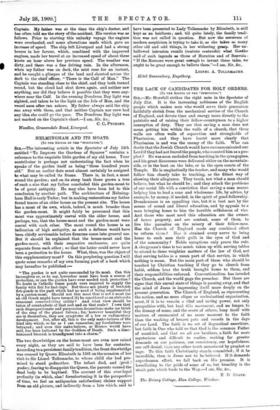HELMINGHAM AND ITS MOATS.
[TO THE EDITOR OF THE "SPECTATOR:]
Srs,—The interesting article in the Spectator of July 14th entitled "To Improve the Gardens of Squares" contains a reference to the exquisite little garden of my old home. Your contributor is perhaps not understating the fact when he speaks of the garden itself as being "three hundred years old." But an earlier date must almost certainly be assigned to what may be called its frame. There is, in fact, a moat round the garden ; and on its steep bank there grows a tree of such a size that my father concluded this garden-moat to be of great antiquity. He may also have been led to this conclusion by another path. The architecture of Helming- ham Hall is early Tudor; but in making restorations my father found traces of an older house on the present site. The house has a moat of its own, which, indeed, is much broader than the garden-moat. It might fairly be presumed that this moat was approximately coeval with the older house, and perhaps, too, that the house-moat and the garden-moat were coeval with each other. The moat round the house is an indication of high antiquity, as such a defence would have been chiefly serviceable before firearms came into general use. But it should be explained that the house-moat and the garden-moat, with their respective enclosures, are quite separate from each other ; so that the latter could never have been a protection to the house. What, then, was the object of this supplementary moat? On this perplexing question Twill quote some remarks of my own forming part of a book which may hereafter be published:— " The garden is not quite surrounded by its moat. Can this incomplete or, so to say, horseshoe moat have been a source of protection, or can the garden have ever needed such protection ? No doubt in Catholic times ponds were required to supply the family with fish for fast-days. But there are plenty of bond-fide fish-ponds in the park which had no need of being supplemented by a garden-moat. Should not this moat that is not a moat (as an old Greek might have termed it) be considered as an elaborate ornament counterfeiting utility ? And what view should be taken of counterfeits of that sort and on that scale ? I own that such disproportionate and purposeless decorations make me think of the ring of the planet Saturn ; for,"however beautiful they are in themselves, they are symptoms of a low or rudimentary development. But, after all, this is the only make-believe of the kind into which, so far as I can remember, my forefathers were betrayed; and even this make-believe, as Horace would have said, has been hallowed by the Goddess of Death. Such a time- honoured blemish is transfigured into a charm."
The two drawbridges on the house-moat are even now raised every night, as they are said to have been for centuries. According to a persistent family tradition, the front drawbridge was crossed by Queen Elizabeth in 1561 on the occasion of her visit to Sir Lionel Tollemache, to whose child she had pro- mised to stand godmother. The infant died, and (proh ! ioador), fearing to disappoint the Queen, the parents caused the
dead body to be baptised. The account of this over-loyal profanity (in which, alas! foreshortening it in the perspective of time, we feel an antiquarian satisfaction) claims support from an old picture, and indirectly from a lute which, said to
have been presented to Lady Tollemache by Elizabeth, is still kept as an heirloom; and, till quite lately, the family tradi- tion was not called in question. But now the sorceress of modern scepticism is trying to take it, as she takes so many other old and odd things, in her withering grasp. Her us- hallowed intrusion recalls (nvutatis matandis) what Goethe said of such legends as those of Horatius and of Scievola : "If the Romans were great enough to invent these tales, we ought to be great enough to believe them."—I am, Sir, &c., 'Aortal. A. TOLLEILACHE.
Hotel Sonnenberg, Engelberg.


































 Previous page
Previous page